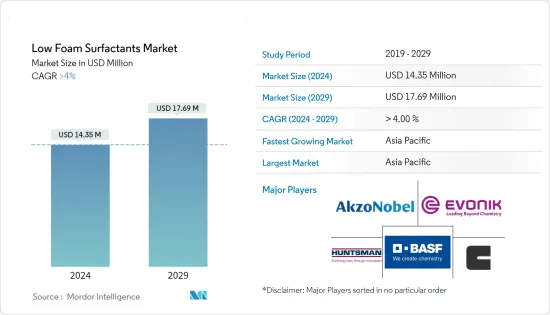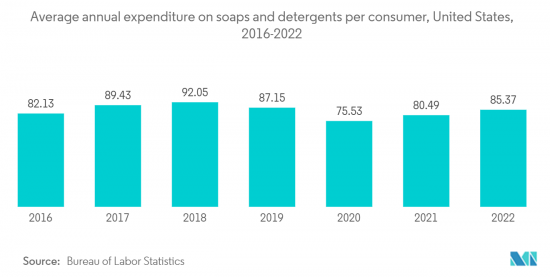 |
市场调查报告书
商品编码
1406159
低发泡介面活性剂:市场占有率分析、产业趋势与统计、2024年至2029年成长预测Low Foam Surfactants - Market Share Analysis, Industry Trends & Statistics, Growth Forecasts 2024 - 2029 |
||||||
※ 本网页内容可能与最新版本有所差异。详细情况请与我们联繫。
低发泡介面活性剂市场规模预计到2024年为1435万美元,预计到2029年将达到1769万美元,在预测期内(2024-2029年)复合年增长率将超过4%。

COVID-19大流行在一定程度上对低发泡介面活性剂市场产生了积极影响。世界各国政府安全措施的实施和卫生意识的提高对清洁剂和清洗剂的市场需求产生了积极影响,从而带动了低发泡介面活性剂的市场需求。在 COVID-19之后,由于农业化学品、食品和乳製品加工、清洗产品、清洁剂和清洗以及油田化学品对低发泡介面活性剂的需求增加,市场不断增长。
主要亮点
- 清洁剂和清洗剂的显着增长、对永续介面活性剂的需求不断增加以及对个人护理产品的需求不断增长预计将推动当前的研究市场。
- 另一方面,严格的环境法规和其他替代品的可用性预计将阻碍市场成长。
- 生物基介面活性剂的开拓预计将在预测期内创造市场机会。
- 预计亚太地区将主导市场。由于农业化学品和农业化学品中对低发泡介面活性剂的需求不断增长,预计其增长也将达到最高。
低发泡介面活性剂的市场趋势
清洁剂和清洗剂终端用户产业主导市场
- 低发泡介面活性剂广泛用于居家护理应用,例如洗衣精、洗碗机清洁剂、地毯清洁剂、地板清洁剂和多种类型的织物整理加工剂。此外,它不受水硬度的影响。
- 非离子介面活性剂与其他介面活性剂混合,广泛用于工业清洗应用。对更环保和永续的介面活性剂的需求预计将成为低发泡介面活性剂市场的最新趋势。玩家正在转向使用草药和生物分解性介面活性剂製造低泡沫表面活性剂。
- 北美和亚太地区是全球最大的清洁剂和清洗产品市场。在亚太地区,清洁剂的需求主要在中国和印度等国家增加。对清洁剂的需求不断增长,促使宝洁等公司在印度投资清洁剂业务。例如,2022 年 5 月,宝洁公司投资约 20 亿印度卢比(2,605 万美元)在印度特伦甘纳邦新建液体清洁剂製造工厂。因此,液体清洁剂产量的增加可能会推动低发泡介面活性剂市场的发展。
- 美国是世界上最大的肥皂和清洁剂市场之一。根据美国劳工统计局的数据,2022 年美国每位消费者在肥皂和清洁剂上的平均年支出将达到约 85.37 美元,比与前一年同期比较增长 6%。
- 同样,欧洲对清洁剂和清洗产品的需求也在增加。根据 AISE(国际肥皂、清洁剂和保养产品协会)的数据,2022 年洗衣精市场价值将达到 171.4 亿美元(158 亿欧元),高于前上年度的162.1 亿美元(149.4 亿欧元)。成长率为5.4%。因此,洗衣护理清洁剂市场的扩张预计将推动当前的研究市场。
- 因此,预计清洁剂和清洗剂最终用户产业将在预测期内主导低发泡介面活性剂市场。

亚太地区是成长最快的市场
- 由于印度、中国和日本等国家各种最终用户应用的需求不断增加,预计亚太地区在预测期内将主导低发泡清洁剂市场。
- 在中国和印度等国家,生活方式的改变和产品的广泛适用性正在推动低发泡清洁剂市场的发展。可支配收入和购买力的增加支持了成长,从而推动了家庭和个人护理行业对低发泡介面活性剂的需求。
- 在个人护理应用中,由于其抗菌、发泡、调理、温和清洗和防腐性能,被用于洗髮精、洗面乳、护肤护肤霜等。全部区域个人护理产品需求的增加,该产品的需求预计将激增。
- 在中国,个人护理行业是成长最快的行业之一。根据CHINABRIEF报告,预计2025年,中国化妆品及个人护理市场规模将达780亿美元。
- 同样,在印度,个人护理和卫生市场正在经历高速成长,因为它响应了不断变化的消费者价值观和期望。据印度投资局称,2022 年个人护理和卫生用品市场价值为 150.5 亿美元,预计到 2026 年将达到 173.4 亿美元。因此,中国和印度个人护理和卫生市场的成长将推动该地区当前的研究市场。
- 此外,在中国,随着石油和天然气探勘活动的活性化,油田化学品市场正在不断扩大。多家跨国公司正在中国扩大其油田化学品业务。
- 因此,清洁剂和清洗产品、个人护理产品和油田化学品製造中对低发泡介面活性剂的需求不断增长,预计将在预测期内推动该地区的市场。
其他福利:
- Excel 格式的市场预测 (ME) 表
- 3 个月的分析师支持
目录
第一章简介
- 调查先决条件
- 调查范围
第二章调查方法
第三章执行摘要
第四章市场动态
- 促进因素
- 清洁剂和清洗产品显着增长
- 对永续介面活性剂的需求不断增长
- 个人护理产品需求不断成长
- 抑制因素
- 严格的环境法规
- 其他替代品的可得性
- 产业价值链分析
- 波特五力分析
- 供应商的议价能力
- 买方议价能力
- 新进入者的威胁
- 替代品的威胁
- 竞争程度
第五章市场区隔(市场规模)
- 类型
- 双性恋
- 阳离子
- 非离子型
- 最终用户产业
- 农药
- 食品和乳製品清洗剂
- 清洁剂和清洗剂
- 纸浆/造纸製造
- 金属清洗/金属加工油
- 油田化学品
- 其他(纺织品、个人护理品等)
- 地区
- 亚太地区
- 中国
- 印度
- 日本
- 韩国
- 亚太地区其他地区
- 北美洲
- 美国
- 加拿大
- 墨西哥
- 欧洲
- 德国
- 英国
- 义大利
- 法国
- 欧洲其他地区
- 南美洲
- 巴西
- 阿根廷
- 南美洲其他地区
- 中东/非洲
- 沙乌地阿拉伯
- 南非
- 中东和非洲其他地区
- 亚太地区
第六章竞争形势
- 併购、合资、联盟、协议
- 市场占有率(%)**/排名分析
- 主要企业策略
- 公司简介
- AkzoNobel NV
- BASF SE
- Clariant AG
- Croda International plc
- Dow
- Evonik Industries AG
- Huntsman International LLC
- KAO CORPORATION
- Nufarm
- Oxiteno SA
- Solvay
- Stepan Company
第七章 市场机会及未来趋势
- 生物基介面活性剂的开发
- 其他机会

The Low Foam Surfactants Market size is estimated at USD 14.35 million in 2024, and is expected to reach USD 17.69 million by 2029, growing at a CAGR of greater than 4% during the forecast period (2024-2029).
The COVID-19 pandemic positively affected the market for low-foam surfactants to some extent. The implementation of safety measures by various governments across the globe and the increasing awareness about hygiene positively impacted the market demand for detergents and cleaning agents, thereby driving the market demand for low-foam surfactants. Post-COVID-19, the market grew due to the increasing demand for low-foam surfactants in agrochemicals, food and dairy processes, cleaners, detergents and cleaning agents, and oilfield chemicals.
Key Highlights
- The significant growth in detergents and cleaning agents, increased demand for sustainable surfactants, and the rising demand for personal care products are expected to drive the current studied market.
- On the flip side, the stringent environmental regulations and the availability of other substitutes are expected to hinder the growth of the market.
- The development of bio-based surfactants is expected to create opportunities for the market during the forecast period.
- The Asia-Pacific region is expected to dominate the market. It is also expected to register the highest growth due to the rising demand for low foam surfactants in agrochemicals and agrochemicals.
Low Foam Surfactants Market Trends
Detergents and Cleaning Agents End-user Industry Segment to Dominate the Market
- Low foam surfactants are extensively employed in home care applications like laundry detergents, dishwasher detergents, carpet cleaners, floor cleaners, and several types of fabric softeners. In addition, they are not affected by the hardness of water.
- Non-ionic surfactants are mixed with other surfactants and are widely used in industrial cleaning applications. Demand for greener & sustainable surfactants is anticipated to be the latest trend in the low foam surfactants market. Players are transitioning towards manufacturing low-foam surfactants with herbal and biodegradable compounds.
- North America and Asia-Pacific are the largest markets for detergents and cleaning agents across the world. In the Asia-Pacific region, the demand for detergents is mainly increasing in countries like China and India. Owing to the rising demand for detergents, firms such as Procter & Gamble are investing in a detergent business in India. For instance, in May 2022, Procter & Gamble started a new liquid detergent manufacturing unit in Telangana, India, with an investment of around INR 2,000 million (USD 26.05 million). Thus, the rising production volumes of liquid detergents will drive the market for low-foam surfactants.
- The United States is one of the largest markets for soaps and detergents across the world. According to the Bureau of Labor Statistics, the average annual expenditures for soaps and detergents in the United States amounted to roughly USD 85.37 per consumer unit in 2022, reflecting an increase of 6% compared to the previous year.
- Similarly, in Europe, the demand for detergents and cleaning agents is increasing. According to A.I.S.E ( International Association for Soaps, Detergents and Maintenance Products), the market for laundry care detergents is registered at USD 17.14 billion (EUR 15.8 billion) in 2022, as compared to USD 16.21 billion (EUR 14.94 billion) reported in the previous year at a growth rate of 5.4%. Thus, the increasing market for laundry care detergents is expected to drive the current studied market.
- Thus, the detergents and cleaning agents end-user industry segment will dominate the market for low foam surfactants during the forecast period.

Asia Pacific Region to be the Fastest Growing Market
- The Asia-Pacific region is expected to dominate the market for low-foam detergents during the forecast period due to increased demand from various end-user applications in countries like India, China, and Japan.
- In countries like China and India, the changes in the lifestyle and wide scope of application of the product are driving the market for low-foam detergents. The increasing disposable income and purchasing power support the growth, which in turn has increased the demand for low-foam surfactants in the home & personal care industry.
- In personal care applications, they exhibit antimicrobial properties, foaming & conditioning properties, mild detergency actions, and preservative properties and hence are being used in shampoos, face washes, and skincare creams. The increasing demand for personal care products across the region is expected to surge the demand for the product.
- In China, the personal care industry is one of the fastest-growing sectors. According to CHINABRIEF, the cosmetics and personal care market in the country is expected to reach USD 78 billion by 2025.
- Similarly, in India, the personal care and hygiene market is growing at a higher rate to deal with evolving consumer values and expectations. According to Invest India, the personal care and hygiene market is valued at USD 15.05 billion in 2022 and is expected to reach USD 17.34 billion by 2026. Thus, the growth in the personal care and hygiene markets in China and India will drive the current studied market in the region.
- Furthermore, in China, the market for oilfield chemicals is increasing with the rising oil and gas exploration activities in the country. Several global companies are expanding their operations of oil field chemicals in China. For instance, in March 2023, Aramco, one of the world's major integrated energy and chemicals companies, signed definitive agreements to acquire a 10% interest in Shenzhen-listed Rongsheng Petrochemical Co. Ltd in China. The acquisition will help to increase the production volume of oilfield chemicals in the country, thereby driving the market for low-foam surfactants.
- Thus, the rising demand for low-foam surfactants in the manufacturing of detergents and cleaning agents, personal care products, and oil field chemicals is expected to drive the market in the region during the forecast period.
Low Foam Surfactants Industry Overview
Low Foam Surfactants market is partially consolidated in nature. Some of the major players in the market (not in any particular order) include AkzoNobel N.V., BASF SE, Clariant AG, Evonik Industries AG, and Huntsman International LLC, among others.
Additional Benefits:
- The market estimate (ME) sheet in Excel format
- 3 months of analyst support
TABLE OF CONTENTS
1 INTRODUCTION
- 1.1 Study Assumptions
- 1.2 Scope of the Study
2 RESEARCH METHODOLOGY
3 EXECUTIVE SUMMARY
4 MARKET DYNAMICS
- 4.1 Drivers
- 4.1.1 Significant Growth in Detergents and Cleaning Agents
- 4.1.2 Increased Demand for Sustainable Surfactants
- 4.1.3 The rising demand for personal care products
- 4.2 Restraints
- 4.2.1 The Stringent Enviornmental Regulations
- 4.2.2 The Availability of Other Substitutes
- 4.3 Industry Value Chain Analysis
- 4.4 Porter's Five Forces Analysis
- 4.4.1 Bargaining Power of Suppliers
- 4.4.2 Bargaining Power of Buyers
- 4.4.3 Threat of New Entrants
- 4.4.4 Threat of Substitute Products and Services
- 4.4.5 Degree of Competition
5 MARKET SEGMENTATION (Market Size in Value)
- 5.1 Type
- 5.1.1 Amphoteric
- 5.1.2 Cationic
- 5.1.3 Non-ionic
- 5.2 End-user Industry
- 5.2.1 Agrochemicals
- 5.2.2 Food and Dairy Process Cleaners
- 5.2.3 Detergents and Cleaning Agents
- 5.2.4 Pulp and Paper
- 5.2.5 Metal Cleaning and Metal Working Fluids
- 5.2.6 Oilfield Chemicals
- 5.2.7 Others (Textiles, Personal care, etc.)
- 5.3 Geography
- 5.3.1 Asia-Pacific
- 5.3.1.1 China
- 5.3.1.2 India
- 5.3.1.3 Japan
- 5.3.1.4 South Korea
- 5.3.1.5 Rest of Asia-Pacific
- 5.3.2 North America
- 5.3.2.1 United States
- 5.3.2.2 Canada
- 5.3.2.3 Mexico
- 5.3.3 Europe
- 5.3.3.1 Germany
- 5.3.3.2 United Kingdom
- 5.3.3.3 Italy
- 5.3.3.4 France
- 5.3.3.5 Rest of Europe
- 5.3.4 South America
- 5.3.4.1 Brazil
- 5.3.4.2 Argentina
- 5.3.4.3 Rest of South America
- 5.3.5 Middle East and Africa
- 5.3.5.1 Saudi Arabia
- 5.3.5.2 South Africa
- 5.3.5.3 Rest of Middle East and Africa
- 5.3.1 Asia-Pacific
6 COMPETITIVE LANDSCAPE
- 6.1 Mergers and Acquisitions, Joint Ventures, Collaborations, and Agreements
- 6.2 Market Share (%)**/Ranking Analysis
- 6.3 Strategies Adopted by Leading Players
- 6.4 Company Profiles
- 6.4.1 AkzoNobel N.V.
- 6.4.2 BASF SE
- 6.4.3 Clariant AG
- 6.4.4 Croda International plc
- 6.4.5 Dow
- 6.4.6 Evonik Industries AG
- 6.4.7 Huntsman International LLC
- 6.4.8 KAO CORPORATION
- 6.4.9 Nufarm
- 6.4.10 Oxiteno SA
- 6.4.11 Solvay
- 6.4.12 Stepan Company
7 MARKET OPPORTUNITIES AND FUTURE TRENDS
- 7.1 Development of Bio-based Surfactants
- 7.2 Other Opportunities









